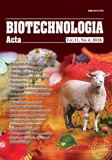ISSN 2410-7751 (Print)
ISSN 2410-776X (Online)

"Biotechnologia Acta" V. 11, No 4, 2018
https://doi.org/10.15407/biotech11.04.084
Р. 84-90, Bibliography 26, English
Universal Decimal Classification: 615.473.92:571.27
EFFECT OF INTRACRANIAL CATHETER PLACEMENT ON MICROGLIA METABOLIC PROFILE OF RATS
Y. Hurmach, М. Rudyk, V. Svyatetskaya, L. Skivka
Taras Shevchenko National University of Kyiv,, ESC “Institute of Biology and Medicine” Kyiv, Ukraine
The aim of the work was to investigate the effect of the intracranial catheter placement on the metabolic profile of rat microglia. Microglial cells were isolated by the centrifugation in Percoll gradient. Oxidative metabolism and phagocytic activity were investigated by flow cytometry. Arginase activity was examined by colorimetric method. Nitrite level was assayed in Griess reaction. It was found that intracranial catheter placement caused down-regulation of nitrite synthesis by 3 times, augmentation of the reactive oxygen species generation by 1.5 times, and slightly decreased microglia phagocytic activity. Thus, intracranial catheter placement causes long term anti-inflammatory shift of microglia metabolism in rats.
Key words: . phagocytes, microglia, metabolic profile, intracranial catheter.
© Palladin Institute of Biochemistry of National Academy of Sciences of Ukraine, 2018
References
1. Abdou E. M., Kandil S. M., Miniawy H. M. Brain targeting efficiency of antimigrain drug loaded mucoadhesive intranasal nanoemulsion. Int. J. Pharm. 2017, 529 (1–2), 667–677. https://doi.org/10.1016/j.ijpharm.2017.07.030
2. Teitelbaum A. M., Gallardo J. L., Bedi J., Giri R., Benoit A. R., Olin M. R., Morizio K. M., Ohlfest J. R., Remmel R. P., Ferguson D. M. 9-Amino acridine pharmacokinetics, brain distribution, and in vitro/in vivo efficacy against malignant glioma. Cancer Chemother. Pharmacol. 2012, 69 (6), 1519–1527. https://doi.org/10.1007/s00280-012-1855-5
3. Fortin D. The blood-brain barrier: its influence in the treatment of brain tumors metastases. Curr. Cancer Drug Targets. 2012, 12 (3), 247–259. https://doi.org/10.2174/156800912799277511
4. Brady M. L., Raghavan R., Mata J., Wilson M., Wilson S., Odland R. M., Broaddus W. C.
Large-Volume Infusions into the Brain: A Comparative Study of Catheter Designs. Stereotact Funct. Neurosurg. 2018, 96 (3), 135–141. https://doi.org/10.1159/000488324
5. Mehta A. M., Sonabend A. M., Bruce J. N. Convection-Enhanced Deliverу. Neuro therapeutics. 2017, 14 (2), 358–371. https://doi.org/10.1007/s13311-017-0520-4
6. Miyake M. M., Bleier B. S. The blood-brain barrier and nasal drug delivery to the central nervous system. Am. J. Rhinol. Allergy. 2015, 29 (2), 124–127. https://doi.org/10.2500/ajra.2015.29.4149
7. Agarwal S., Sane R., Oberoi R., Ohlfest J. R., Elmquist W. F. Delivery of molecularly targeted therapy to malignant glioma, a disease of the whole brain. Expert Rev. Mol. Med. 2011, 13, 17. https://doi.org/10.1017/S1462399411001888
8. Smilowitz H. M., Meyers A., Rahman K., Dyment N. A., Sasso D., Xue C., Oliver D. L., Lichtler A., Deng X., Ridwan S. M., Tarmu L. J., Wu Q., Salner A. L., Bulsara K. R., Slatkin D. N., Hainfeld J. F. Intravenously-injected gold nanoparticles (AuNPs) access intracerebral F98 rat gliomas better than AuNPs infused directly into the tumor site by convection enhanced deliverу. Int. J. Nanomed. 2018, 13, 3937–3948. https://doi.org/10.2147/IJN.S154555
9. Du L., Zhang Y., Chen Y., Zhu J., Yang Y., Zhang H. L. Role of Microglia in Neurological Disorders and Their Potentials as a Therapeutic Target. Mol. Neurobiol. 2017, 54 (10), 7567–7584. https://doi.org/10.1007/s12035-016-0245-0
10. Orihuela R., McPherson C. A., Harry G. J. Microglial M1/M2 polarization and metabolic states. Br. J. Pharmacol. 2016, 173 (4), 649–665. https://doi.org/10.1111/bph.13139
11. Dheen S. T., Kaur C., Ling E. A. Microglial activation and its implications in the brain diseases. Curr. Med. Chem. 2007, 14 (11), 1189–1197 https://doi.org/10.2174/092986707780597961
12. Reznikov A. Ethics problems during conducting of experimental medical and biological researches on animals. Vestn. NAN Ukrainy. 2001, 1, 5–7. (In Russian).
13. Patent of Ukraine for invention No. 114580 dated June 26, 2017.
14. Cantinieaux B., Hariga C., Courtoy P., Hupin J., Fondu P. Staphylococcus aureus phagocytosis. A new cytofluorometic method using FITC and paraformaldehyde. J. Immunol. Meth. 1989, 121 (2), 203–208. https://doi.org/10.1016/0022-1759(89)90161-0
15. Woo J. M., Shin D. Y., Lee S. J., Joe Y., Zheng M., Yim J. H., Callaway Z., Chung H. T. Curcumin protects retinal pigment epithelial cells against oxidative stress via induction of heme oxygenase 1 expression and reduction of reactive oxygen. Mol. Vis. 2012, 8, 901–908.
16. Classen Andrea. Macrophage Activation: Classical Vs. Alternative. Macrophages and Dendritic Cells. Methods and Protocols. Reiner, Neil E (Ed.). New York: Humana press. 2009, 29–43.
17. Rebrova O. Y. Statistical analysis of medical data. Media sfera. 2002, 312. (In Russian).
18. Hesterberg R. S., Cleveland J. L., Epling-Burnette P. K. Role of Polyamines in Immune Cell Functions. Med. Sci. (Basel). 2018, 6 (1), 22. https://doi.org/10.3390/medsci6010022
19. Hussain T., Tan B., Ren W., Rahu N., Kalhoro D. H., Yin Y. Exploring polyamines: Functions in embryo/fetal development. Anim. Nutr. 2017, 3 (1), 7–10. https://doi.org/10.1016/j.aninu.2016.12.002
20. Martinez F. O., Sica A., Mantovani A., Locati M. Macrophage activation and polarization. Front. Biosci. 2008, 13, 453–461. https://doi.org/10.2741/2692
21. Calabrese V., Cornelius C., Rizzarelli E., Owen J. B., Dinkova-Kostova A. T., Butterfield D. A. Nitric oxide in cell survival: a janus molecule. Antioxid. Redox Signal. 2009, 11 (11), 2717–2739. https://doi.org/10.1089/ARS.2009.2721
22. Rath M., M?ller I., Kropf P., Closs E. I., Munder M. Metabolism via Arginase or Nitric Oxide Synthase: Two Competing Arginine Pathways in Macrophages. Front. Immunol. 2014, 5, 532. https://doi.org/10.3389/fimmu.2014.00532
23. Kvietys P. R., Granger D. N. Role of reactive oxygen and nitrogen species in the vascular responses to inflammation. Free Radic. Biol. Med. 2012, 52 (3), 556–592. https://doi.org/10.1016/j.freeradbiomed.2011.11.002
24. Yang Y., Zhu Y., Xi X. Anti-inflammatory and antitumor action of hydrogen via reactive oxygen species. Oncol. Lett. 2018, 16 (3), 2771–2776. https://doi.org/10.3892/ol.2018.9023
25. Forrester S. J., Kikuchi D. S., Hernandes M. S., Xu Q., Griendling K. K. Reactive Oxygen Species in Metabolic and Inflammatory Signaling. Circ. Res. 2018, 122 (6), 877–902. https://doi.org/10.1161/CIRCRESAHA.117.311401
26. R?szer T. Understanding the Mysterious M2 Macrophage through Activation Markers and Effector Mechanisms. Mediators Inflamm. 2015, 2015, 816460. https://doi.org/10.1155/2015/816460

